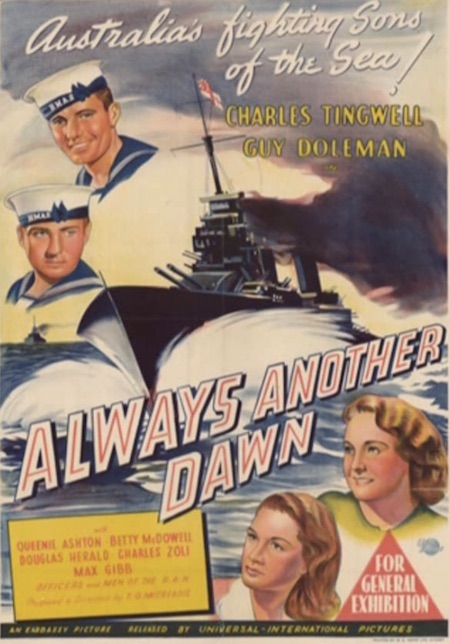

Always Another Dawn (T. O. McCreadie, 1947)
Pike & Cooper:
Production Company: McCreadie Brothers Embassy Pictures. Executive Producer: A K McCreadie. Producer: T O McCreadie. Screenplay, Scenario, Script: Zelma Roberts, T O McCreadie. Photography: Harry Malcolm. Editor: Alex Ezard. Art Director: Edmund Barrie. Special Effects: Arthur Hansen. Musical Director: Iris Mason, Hal Saunders. Song: 'Men of the RAN' by T O McCreadie. 'Dawn Concerto' by Wilbur Kentwell. Sound: Beresford Hallett, John Heath. 108 mins.
Cast: Charles Tingwell (Terry Regan), Guy Doleman (Warren Melville), Queenie Ashton (Molly Regan), Betty McDowall (Patricia), Douglas Herald (the Commodore), Charles Zoli (Scotty McGrath), Russell Jarrett (Dixie Dean), Max Gibb (Bill Carson), Brian Farmer (Kanga Campbell), William J Mason (James T Henderson), Norton Howarth (tanker captain), David Lowe (tanker mate), Glenn Clark (first merchant seaman), Michael Brand (second merchant seaman), Kevin Gunn (postman), Frank Waters (Commander Regan), Terrence Coy (small boy), Lassie (herself), officers and men of the Royal Australian Navy.
During the Second World War Terry Regan enlists in the Australian Navy, inspired by the memory of his father, a naval officer who had died in action in 1916. Terry sees active service in the Mediterranean, and while home on leave, falls in love and promises to marry. Later he is killed when his destroyer engages a Japanese squadron, but a close friend, Warren, survives and resolves to carry on the tradition to which Terry had sacrificed his life.
Always Another Dawn was the first of three features produced by the McCreadie brothers. Tom and his elder brother Alec had formed their production company, Embassy Pictures, in 1940, and had completed several shorts before making a determined entry into feature production. They also had interests in exhibition and distribution, and their work as suburban exhibitors in Sydney extended back to the 1920s. They had also imported several European films for distribution in specialised theatres and had won trade attention in 1946 with a Russian feature, Memory's Harvest, which they had re-recorded with English dialogue - the first time that dubbing had been attempted locally. Their production venture eventually foundered in 1950 because of internal disagreements and financial problems.
With their first feature they took pains to achieve a veneer of authenticity, and the naval scenes shot at the Flinders Naval Depot, Sydney, and on board HMAS Bataan during exercises, emerged with strong documentary interest. Shooting began in February 1947 with a budget of £30,000 and lasted some six months. Technical services and a studio were provided by Commonwealth Film Laboratories, Sydney. Distributed by Universal, the film opened at the Embassy Theatre, Sydney, on 24 September 1948, but critical opinion was adverse and it ran for only two weeks. Critics drew attention to banal dialogue and the many platitudes about war and tradition, but a boxing match and a passionate piano concerto (played by the dead hero's friend) were seen as some compensation.
In 1949, a version shortened to 73 minutes was released in England by Eros Films, and in this abridged form it won far kinder comments from the press; the Monthly Film Bulletin, June 1949, found it 'quietly moving and sincere'.
NFSA:
A moving melodrama of patriotism and courage under fire in the Royal Australian Navy during World War II.
‘The history of officers and men of the Royal Australian Navy through the war years will, for the most part, never be known, yet they won for themselves honour in a service known for its traditions of self-sacrifice and devotion to duty. Now, in the aftermath of war, we may lose sight of many things – including our debt to the past – yet because of that heritage of faith and courage, surely we need never doubt that the day will dawn when we will be able to boast of a worthwhile and lasting peace.’ [Quote from Always Another Dawn]
The Royal Australian Navy provided locations and extras to the filmmakers. Much of the footage for Always Another Dawn was shot at HMAS Cerberus (Flinders Naval Depot) in Western Port Bay Victoria, which was at the time, and remains today, the Navy’s principal training establishment. Battle scenes were filmed during exercises on board tribal class destroyer HMAS Bataan, bringing a documentary-like quality to the film.
'...quietly moving and sincere'. Monthly Film Bulletin, 1949.
Garry Gillard | New: 23 September, 2021 | Now: 23 September, 2021